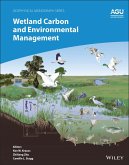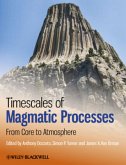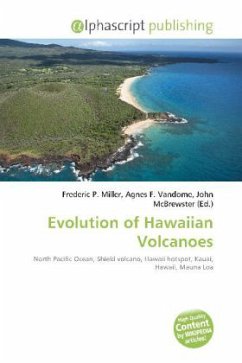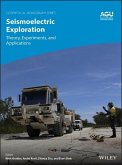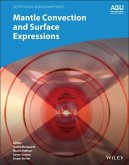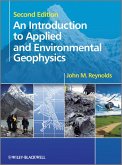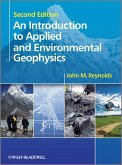Hawaiian Volcanoes
From Source to Surface
Herausgegeben von Carey, Rebecca; Cayol, Valérie; Poland, Michael; Weis, Dominique
Hawaiian Volcanoes
From Source to Surface
Herausgegeben von Carey, Rebecca; Cayol, Valérie; Poland, Michael; Weis, Dominique
- Gebundenes Buch
- Merkliste
- Auf die Merkliste
- Bewerten Bewerten
- Teilen
- Produkt teilen
- Produkterinnerung
- Produkterinnerung
Hawaiian Volcanoes, From Source to Surface is the outcome of an AGU Chapman Conference held on the Island of Hawai'i in August 2012. As such, this monograph contains a diversity of research results that highlight the current understanding of how Hawaiian volcanoes work and point out fundamental questions requiring additional exploration.
Volume highlights include: Studies that span a range of depths within Earth, from the deep mantle to the atmosphere Methods that cross the disciplines of geochemistry, geology, and geophysics to address issues of fundamental importance to Hawai'i's…mehr
![Wetland Carbon and Environmental Management Wetland Carbon and Environmental Management]() Wetland Carbon and Environmental Management251,99 €
Wetland Carbon and Environmental Management251,99 €![Timescales of Magmatic Processes Timescales of Magmatic Processes]() Timescales of Magmatic Processes117,99 €
Timescales of Magmatic Processes117,99 €![Evolution of Hawaiian Volcanoes Evolution of Hawaiian Volcanoes]() Evolution of Hawaiian Volcanoes22,99 €
Evolution of Hawaiian Volcanoes22,99 €![Seismoelectric Exploration Seismoelectric Exploration]() Seismoelectric Exploration232,99 €
Seismoelectric Exploration232,99 €![Mantle Convection and Surface Expressions Mantle Convection and Surface Expressions]() Mantle Convection and Surface Expressions273,99 €
Mantle Convection and Surface Expressions273,99 €![An Introduction to Applied and Environmental Geophysics An Introduction to Applied and Environmental Geophysics]() John M. ReynoldsAn Introduction to Applied and Environmental Geophysics84,99 €
John M. ReynoldsAn Introduction to Applied and Environmental Geophysics84,99 €![An Introduction to Applied and Environmental Geophysics An Introduction to Applied and Environmental Geophysics]() John M. ReynoldsAn Introduction to Applied and Environmental Geophysics178,99 €
John M. ReynoldsAn Introduction to Applied and Environmental Geophysics178,99 €-
-
-
Volume highlights include:
Studies that span a range of depths within Earth, from the deep mantle to the atmosphere
Methods that cross the disciplines of geochemistry, geology, and geophysics to address issues of fundamental importance to Hawai'i's volcanoes
Data for use in comparisons with other volcanoes, which can benefit from, and contribute to, a better understanding of Hawai'i
Discussions of the current issues that need to be addressed for a better understanding of Hawaiian volcanism
Hawaiian Volcanoes, From Source to Surface will be a valuable resource not only for researchers studying basaltic volcanism and scientists generally interested in volcanoes, but also students beginning their careers in geosciences. This volume will also be of great interest to igneous petrologists, geochemists, and geophysicists.
- Produktdetails
- Geophysical Monograph Series
- Verlag: Wiley & Sons
- 1. Auflage
- Seitenzahl: 600
- Erscheinungstermin: 16. März 2015
- Englisch
- Abmessung: 287mm x 217mm x 30mm
- Gewicht: 1473g
- ISBN-13: 9781118872048
- ISBN-10: 1118872045
- Artikelnr.: 41669413
- Geophysical Monograph Series
- Verlag: Wiley & Sons
- 1. Auflage
- Seitenzahl: 600
- Erscheinungstermin: 16. März 2015
- Englisch
- Abmessung: 287mm x 217mm x 30mm
- Gewicht: 1473g
- ISBN-13: 9781118872048
- ISBN-10: 1118872045
- Artikelnr.: 41669413
Richard M. Allen
Rob W. Porritt
and Maxim D. Ballmer 3. Asymmetric Dynamical Behavior of Thermochemical Plumes and Implications for Hawaiian Lava Composition 35 Maxim D. Ballmer
Garrett Ito
and Cheng Cheng 4. Major-Element and Isotopic Variations in Mauna Loa Magmas over 600 ka: Implications for Magma Generation and Source Lithology as Mauna Loa Transits the Hawaiian Plume 59 J. Michael Rhodes 5. Lithium Isotopic Signature of Hawaiian Basalts 79 Lauren Harrison
Dominique Weis
Diane Hanano
and Elspeth Barnes 6. Onset of Rejuvenated-Stage Volcanism and the Formation of L1 hu'e Basin: Kaua'i Events That Occurred 3-4 Million Years Ago 105 David R. Sherrod
Scot K. Izuka
and Brian L. Cousens 7. Evidence for Large Compositional Ranges in Coeval Melts Erupted from K1 lauea's Summit Reservoir 125 Rosalind T. Helz
David A. Clague
Larry G. Mastin
and Timothy R. Rose 8. Petrologic Testament to Changes in Shallow Magma Storage and Transport During 30+ Years of Recharge and Eruption at K1 lauea Volcano
Hawai'I 147 Carl R. Thornber
Tim R. Orr
Christina Heliker
and Richard P. Hoblitt 9. Shallow Magma Storage at Piton de la Fournaise Volcano After 2007 Summit Caldera Collapse Tracked in Pele's Hairs 189 Andrea Di Muro
Thomas Staudacher
Valerie Ferrazzini
Nicole Metrich
Pascale Besson
Christine Garofalo
and Benoit Villemant 10. Analysis of Seismicity Rate Changes and Tilt During Early Episodic Fountaining Stage of Pu'u 'O'o
Hawai'i
Eruption: Implications for Magma Storage and Transport 213 Harmony V. Colella and James H. Dieterich 11. Episodic Deflation-Inflation Events at Kïlauea Volcano and Implications for the Shallow Magma System 229 Kyle R. Anderson
Michael P. Poland
Jessica H. Johnson
and Asta Miklius 12. Crustal Stress and Structure at K1 lauea Volcano Inferred from Seismic Anisotropy 251 Jessica H. Johnson
Donald A. Swanson
Diana C. Roman
Michael P. Poland
and Weston A. Thelen 13. Delicate Balance of Magmatic-Tectonic Interaction at K1 lauea Volcano
Hawai'i
Revealed from Slow Slip Events 269 Emily K. Montgomery-Brown
Michael P. Poland
and Asta Miklius 14. From Reservoirs and Conduits to the Surface: Review of Role of Bubbles in Driving Basaltic Eruptions 289 Sylvie Vergniolle and Yves Gaudemer 15. Insights Into Mixing
Fractionation
and Degassing of Primitive Melts at K1 lauea Volcano
Hawai'I 323 Marie Edmonds
Isobel Sides
and John Maclennan 16. Reticulite-Producing Fountains From Ring Fractures in K1 lauea Caldera ca. 1500 CE 351 Michael May
Rebecca J. Carey
Donald A. Swanson
and Bruce F. Houghton 17. Hawaiian Fissure Fountains: Quantifying Vent and Shallow Conduit Geometry
Episode 1 of the 1969-1974 Mauna Ulu Eruption 369 Carolyn Parcheta
Sarah Fagents
Donald A. Swanson
Bruce F. Houghton
and Todd Ericksen 18. K1 lauea's 5-9 March 2011 Kamoamoa Fissure Eruption and Its Relation to 30+ Years of Activity From Pu'u 'O'o 393 Tim R. Orr
Michael P. Poland
Matthew R. Patrick
Weston A. Thelen
A. Jeff Sutton
Tamar Elias
Carl R. Thornber
Carolyn Parcheta
and Kelly M. Wooten 19. Onset of a Basaltic Explosive Eruption From Kïlauea's Summit in 2008 421 Rebecca J. Carey
Lauren Swavely
Donald A. Swanson
Bruce F. Houghton
Tim R. Orr
Tamar Elias
and A. Jeff Sutton 20. Primitive Components
Crustal Assimilation
and Magmatic Degassing During the Early 2008 Kïlauea Summit Eruptive Activity 439 Michael C. Rowe
Carl R. Thornber
and Tim R. Orr 21. FLOWGO 2012: An Updated Framework for Thermorheological Simulations of Channel-Contained Lava 457 Andrew J. L. Harris and Scott K. Rowland 22. Lava Flows in 3D: Using Airborne Lidar and Preeruptive Topography To Evaluate Lava Flow Surface Morphology and Thickness in Hawai'I 483 Hannah R. Dietterich
S. Adam Soule
Katharine V. Cashman
and Benjamin H. Mackey 23. Are Piton de la Fournaise (La Réunion) and K1 lauea (Hawai'i) Really "Analog Volcanoes"? 507 Aline Peltier
Michael P. Poland
and Thomas Staudacher 24. "Points Requiring Elucidation" About Hawaiian Volcanism 533 Michael P. Poland Index 563
Richard M. Allen
Rob W. Porritt
and Maxim D. Ballmer 3. Asymmetric Dynamical Behavior of Thermochemical Plumes and Implications for Hawaiian Lava Composition 35 Maxim D. Ballmer
Garrett Ito
and Cheng Cheng 4. Major-Element and Isotopic Variations in Mauna Loa Magmas over 600 ka: Implications for Magma Generation and Source Lithology as Mauna Loa Transits the Hawaiian Plume 59 J. Michael Rhodes 5. Lithium Isotopic Signature of Hawaiian Basalts 79 Lauren Harrison
Dominique Weis
Diane Hanano
and Elspeth Barnes 6. Onset of Rejuvenated-Stage Volcanism and the Formation of L1 hu'e Basin: Kaua'i Events That Occurred 3-4 Million Years Ago 105 David R. Sherrod
Scot K. Izuka
and Brian L. Cousens 7. Evidence for Large Compositional Ranges in Coeval Melts Erupted from K1 lauea's Summit Reservoir 125 Rosalind T. Helz
David A. Clague
Larry G. Mastin
and Timothy R. Rose 8. Petrologic Testament to Changes in Shallow Magma Storage and Transport During 30+ Years of Recharge and Eruption at K1 lauea Volcano
Hawai'I 147 Carl R. Thornber
Tim R. Orr
Christina Heliker
and Richard P. Hoblitt 9. Shallow Magma Storage at Piton de la Fournaise Volcano After 2007 Summit Caldera Collapse Tracked in Pele's Hairs 189 Andrea Di Muro
Thomas Staudacher
Valerie Ferrazzini
Nicole Metrich
Pascale Besson
Christine Garofalo
and Benoit Villemant 10. Analysis of Seismicity Rate Changes and Tilt During Early Episodic Fountaining Stage of Pu'u 'O'o
Hawai'i
Eruption: Implications for Magma Storage and Transport 213 Harmony V. Colella and James H. Dieterich 11. Episodic Deflation-Inflation Events at Kïlauea Volcano and Implications for the Shallow Magma System 229 Kyle R. Anderson
Michael P. Poland
Jessica H. Johnson
and Asta Miklius 12. Crustal Stress and Structure at K1 lauea Volcano Inferred from Seismic Anisotropy 251 Jessica H. Johnson
Donald A. Swanson
Diana C. Roman
Michael P. Poland
and Weston A. Thelen 13. Delicate Balance of Magmatic-Tectonic Interaction at K1 lauea Volcano
Hawai'i
Revealed from Slow Slip Events 269 Emily K. Montgomery-Brown
Michael P. Poland
and Asta Miklius 14. From Reservoirs and Conduits to the Surface: Review of Role of Bubbles in Driving Basaltic Eruptions 289 Sylvie Vergniolle and Yves Gaudemer 15. Insights Into Mixing
Fractionation
and Degassing of Primitive Melts at K1 lauea Volcano
Hawai'I 323 Marie Edmonds
Isobel Sides
and John Maclennan 16. Reticulite-Producing Fountains From Ring Fractures in K1 lauea Caldera ca. 1500 CE 351 Michael May
Rebecca J. Carey
Donald A. Swanson
and Bruce F. Houghton 17. Hawaiian Fissure Fountains: Quantifying Vent and Shallow Conduit Geometry
Episode 1 of the 1969-1974 Mauna Ulu Eruption 369 Carolyn Parcheta
Sarah Fagents
Donald A. Swanson
Bruce F. Houghton
and Todd Ericksen 18. K1 lauea's 5-9 March 2011 Kamoamoa Fissure Eruption and Its Relation to 30+ Years of Activity From Pu'u 'O'o 393 Tim R. Orr
Michael P. Poland
Matthew R. Patrick
Weston A. Thelen
A. Jeff Sutton
Tamar Elias
Carl R. Thornber
Carolyn Parcheta
and Kelly M. Wooten 19. Onset of a Basaltic Explosive Eruption From Kïlauea's Summit in 2008 421 Rebecca J. Carey
Lauren Swavely
Donald A. Swanson
Bruce F. Houghton
Tim R. Orr
Tamar Elias
and A. Jeff Sutton 20. Primitive Components
Crustal Assimilation
and Magmatic Degassing During the Early 2008 Kïlauea Summit Eruptive Activity 439 Michael C. Rowe
Carl R. Thornber
and Tim R. Orr 21. FLOWGO 2012: An Updated Framework for Thermorheological Simulations of Channel-Contained Lava 457 Andrew J. L. Harris and Scott K. Rowland 22. Lava Flows in 3D: Using Airborne Lidar and Preeruptive Topography To Evaluate Lava Flow Surface Morphology and Thickness in Hawai'I 483 Hannah R. Dietterich
S. Adam Soule
Katharine V. Cashman
and Benjamin H. Mackey 23. Are Piton de la Fournaise (La Réunion) and K1 lauea (Hawai'i) Really "Analog Volcanoes"? 507 Aline Peltier
Michael P. Poland
and Thomas Staudacher 24. "Points Requiring Elucidation" About Hawaiian Volcanism 533 Michael P. Poland Index 563


